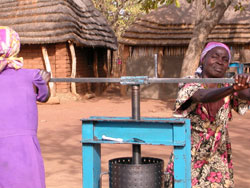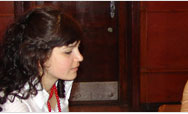You are here » Home » Telling Our Story
Success Story
Women use shea nuts to make high-value goods such as oil and body lotion
Lulu Harvest Yields Livelihoods

| |
Photo: Lulu Works
|
|
Women use a press to extract oil from the lulu nuts.
The Lulu Livelihoods Program has 36 field facilities in areas where lulu trees thrive. Collection points and larger processing centers with machines for cracking the hard nuts are located in Yei, Kajo Keji, Mundri East and West, Lopit, Mvolo, Rumbek, Ceubet, Tonj, and Wau.
|
The shea nut tree — known in Arabic as lulu — grows in a narrow swath below the Sahara from Senegal to Ethiopia. In Sudan, the tree thrives in the Bahr al Ghazal and Equatoria regions, where it has been used for centuries for oil and food.
In 2001, the Lulu Livelihoods Program began developing the market potential of lulu in Southern Sudan, with support from USAID. Today, the program supports 36 Lulu Works processing centers, owned and operated by women, that produce shea butter moisturizer and soap, as well as a substantial, sustainable, local source of income for 850 Sudanese women, their families, and their communities.
The 2005 lulu nut harvest was small in Bahr al Ghazal, but revenue still tripled. In Equatoria, where the harvest was plentiful, the six processing centers produced 5,530 liters of oil during the last half of 2005. The 100 women involved in production each earned $116, compared to an average yearly income of $90. Another 100 nut collectors, mostly women, each earned about $55. Of the 2005 production, 4,080 liters of lulu oil were sent as part of a food program to displaced people in camps in Kajo Keji, Sudan’s southernmost county. In the lucrative Kenyan market, 1,450 liters of cold-pressed lulu body lotion were sold for $26 a liter. Lulu body lotion sales in 2005 in Kenya reached $19,300 — over three times higher than 2004 sales — and demand has started to exceed production.
Due to good rains in 2005, the lulu trees are full of nuts across Southern Sudan, and with continued USAID support, the program expects a dramatic rise in production in 2006. To capture more of the harvest, five new nut collection centers will supply six new processing centers in areas rich in lulu trees, generating income for 200 more nut collectors. The Lulu Livelihoods Program also plans to expand marketing in East Africa, test a few select international outlets, and sell more widely to other markets in Sudan where shea butter is valued.
The program has opened a small store in Wau, where shea body butter will be test retailed at $22 a liter. Lulu products will also be sold in Juba town through an urban cooperative, and the program will continue to supply relief efforts with up to 10,000 liters of cooking oil and household soap.
Print-friendly version of this page (489kb - PDF)
Click here for high-res photo
Back to Top ^ | 

